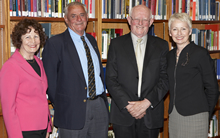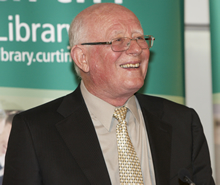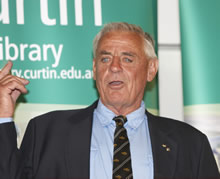
Three times around the world
Launch of the Project Endeavour Collection by Professor John Penrose and Curtin University Library Public Lecture by Jon Sanders AO OBE CitWA
Curtin University of Technology, 2 November 2009
Official Launch of the Collection by Professor John Penrose
Thank you Vice Chancellor. We are here this evening to launch the Project Endeavour Collection and to hear from Jon Sanders. The Collection represents and celebrates the most remarkable feat of solo sailing yet achieved, involving three non stop circuits of the world ocean, with no reprovisioning over the 22 months of the voyage and a unique package of scientific activities.
The Collection has been over 20 years in the making. It comprises written and photographic records of the Project itself and of the preparation of the vessel Parry Endeavour, log books and movie footage taken by Jon during the voyage and images from his sail past Fremantle at the time of the America's Cup and of his return. It holds letters written by Jon during the voyage and the results of oral history interviews with him and other participants in the project. The Collection also contains records of the science projects undertaken by Jon during the voyage, notably the echo sounder records revealing a 3km high seamount in the South Pacific.
This material is housed in the John Curtin Prime Ministerial Library and is available on the website shown on the bookmarks provided on your seat.

The speakers at the launch of the Project Endeavour Collection, 2 November 2009: University Librarian Imogen Garner, Jon Sanders, Professor John Penrose and Vice-Chancellor Professor Jeanette Hacket
Project Endeavour involved many people and organizations in support of Jon's achievements. Central was Kevin Parry and the Parry Corporation and it is a pleasure to welcome Kevin here tonight. The then Western Australian Institute of Technology and from 1987, Curtin University played a variety of roles, the most recent of which we are seeing tonight with the central role of the Curtin University Library.
From the outset of the project our institution was supportive. Areas of the University as diverse as personnel, accounts, public relations and the vice chancellery were involved. In this regard Don Watts and John de Laeter, who are here tonight, merit special recognition. Our Centre for Marine Science and Technology had key roles in the vessel preparation, in the science component and in monitoring Jon's progress throughout the voyage. I would like to especially acknowledge Kim Klaka, Tim Pauly and Wayne Arcus of CMST, who are with us tonight. Jim Chute and Des Piesse, neither of whom are able to be with s tonight because of health reasons played central roles in the vessel preaparation.

Emeritus Professor John Penrose launches the Project Endeavour Collection, 2 November 2009.
One aspect of the science package was unique and led to the name of the project and part of the vessel name. In about 1985 I was asked to discuss with Jon the possibility of developing a package of marine science activities which was suited to the voyage and workable for him. As a result we went back into history and recalled part of the remit given to James Cook and his 18th century voyages in the barque Endeavour. One task was to search for the 'Great South Land'. For some time, since the pattern of the Earth's land masses had become largely understood, there had been a view held by many that a large land mass in the South Pacific was necessary to balance the Eurasian land in the northern hemisphere. So it was that Cook's voyage tracks included substantial coverage between New Zealand and South America without, as we know, discovering any large land mass. In the 1980's particularly the science community became aware of the results from an instrument called a satellite altimeter. These results show the shape of the surface of the ocean. The physics leading to this shape means that where there is an underlying seamount or ridge, the surface will form a mound, while over a trench, a hollow will form in the ocean surface. We took the opportunity to scan the altimeter results for the South Pacific and noted a large mound close to a likely path that Jon could take in that area. So it was that Parry Endeavour was fitted with a powerful echo sounder and we were able to measure the ocean depth down to six kilometres. So it was that the project became Project Endeavour and the vessel Parry Endeavour.
Jon Sanders needs no introduction, but let me make one comment before handing over to him. This comment shows, I think, something of the regard the Western Australian community had for Jon even before Project Endeavour and something of the nature of the man himself . In the early weeks of our discussions, Jon suggested that I might meet with him at his then home just off the Mitchell Freeway. He said "come off at the Powis Street exit and follow it along". That puts you on, of course, Jon Sanders Drive.
And so, it is my great pleasure to declare the Project Endeavour Collection formally launched and to ask Jon Sanders to address us.

Jon Sanders reflects on his historic solo, triple circumnavigation of the world at the launch of the Project Endeavour Collection, 2 November 2009
 |
|||||||||||